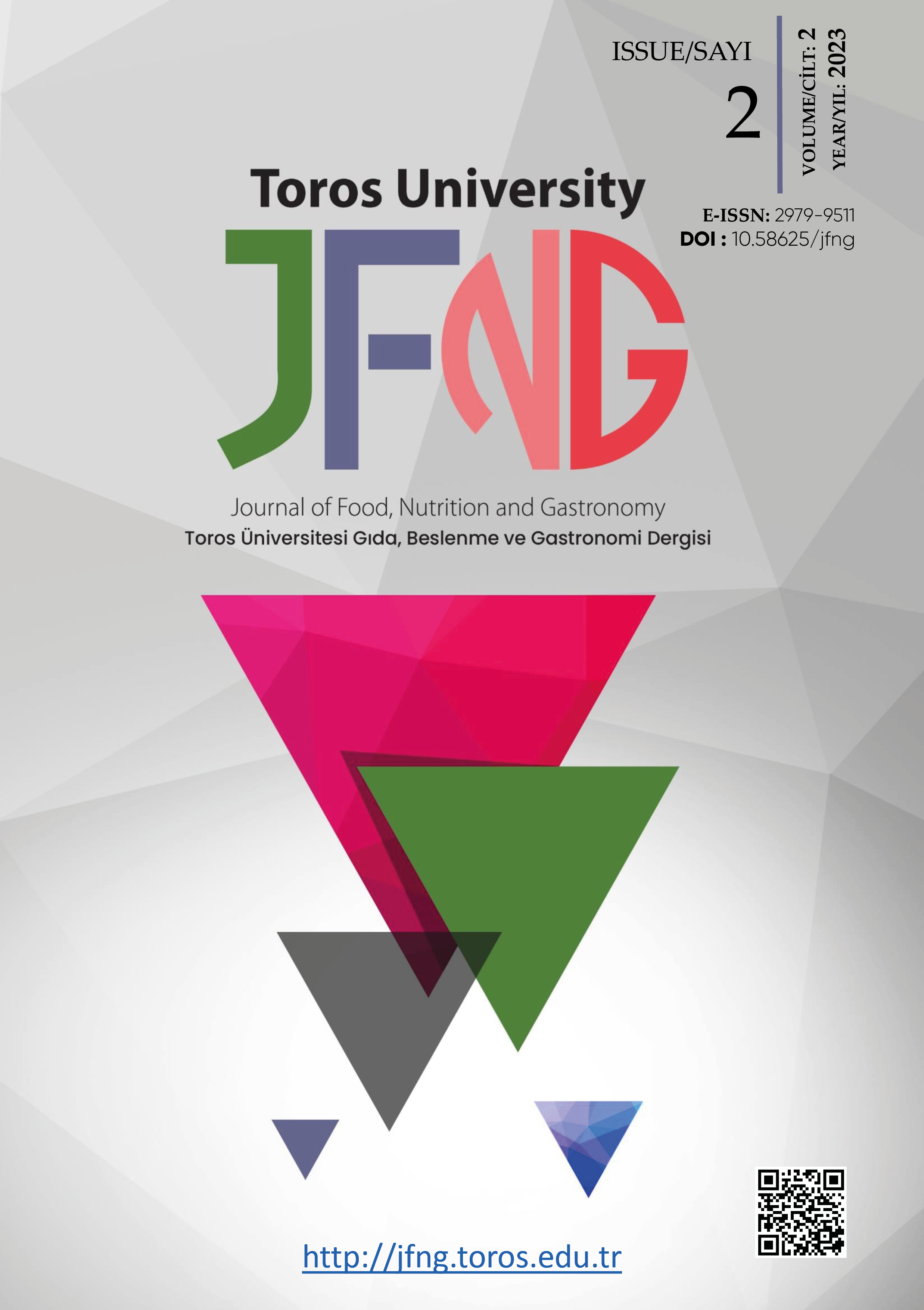Abstract
Carob molasses pulp flour (CMP), rich in fibers, minerals, and polyphenolics that can benefit human health and have a high potential as a dietary source, is a waste or by-product of carob molasses and carob syrup production. In this study, the effect of adding industrial food waste CMP to commonly consumed cake to develop inexpensive food products with increased nutritional value on the textural, physical, and sensory qualities of the cake was investigated. In this study, 5, 10, and 15% CMP were used instead of wheat flour in the cake, and its quality characteristics were investigated. Weight loss was 14.50±0.1% and volume was 101.83±0.7 dm3 for the control cake, and it was similar in all samples. Although the hardness of the CMP15 cake (480.95±94.5 g) was slightly increased (p<0.05), CMP05 and CMP10 had similar textures compared to the control cake (368.75±33.4 g). The highest color values belonged to the control cake (L*=60.68±0.71 and b*=45.79±0.47). The cake colors strongly depended on the CMP. CMP increased cocoa-like color, which was preferred and desired by some consumers. In conclusion, the utilization of CMP did not significantly change the volume, weight loss, texture, and sensorial properties of cake samples according to the control. According to the findings, up to 15% of CMP can be added to the cake recipes with high sensory acceptance, and without any decrease in quality parameters. As a result, CMP, which is thought to be extremely rich in fibers, minerals, and polyphenolics, may be very suitable as a natural additive or substitute material for many foodstuffs, such as functional foods.
References
Altug Onogur, T., & Elmaci, Y. (2015). Sensory Evaluation on Foods. Sidas Publishing. 2nd ed., pp.135. İzmir, Türkiye.
Aydogdu, A., Sumnu, G. & Sahin, S. (2018). Effects of addition of different fibers on rheological characteristics of cake batter and quality of cakes. Journal of Food Science and Technology, 55, 667–677. https://doi.org/10.1007/s13197-017-2976-y.
Berk, E., Şumnu, S. G., Şahin, S. (2017). Effects of hydrocolloids and carob bean flour on rheological properties of batter and cake quality. Gıda, 42(6), 754- 762.
El-Beltagi, H. S., Ahmed, A. R., Mohamed, H. I., Al-Otaibi, H. H., Ramadan, K. M., & Elkatry, H. O. (2023). Utilization of prickly pear peels flour as a natural source of minerals, dietary fiber, and antioxidants: effect on cakes production. Agronomy, 13(2), 439.https://doi.org/10.3390/agronomy13020439.
Fennema, O.R. (1996). Food Chemistry (3rd ed.). New York, Marcel Dekker
Fidan, H.; Petkova, N.; Sapundzhieva, T.; Baeva, M.; Goranova, Z.; Slavov, A.; & Krastev, L. Carob syrup and carob flour (Ceratonia siliqua L.) as functional ingredients in sponge cakes. (2019). Carpathian Journal of Food Science and Technology, 11, 71–82.
Grigelmo-Miguel & Martin-Belloso, (1999). Comparison of dietary fibre from by-products of processing fruits and greens and from cereals. LWT-Food Science and Technology, 32, 503- 508.
Haber, B., (2002). Carob fibre benefits and applications. Cereal Foods World, 47, 365-369.
Hosseini, A., & Pazhouhandeh, F. (2023). Production of enriched cakes by apple pulp and peel powder and evaluation of chemical, functional and textural properties. Vitae, 30(1). https://doi.org/10.17533/udea.vitae.v30n1a349519.
İlhan, S., (2013). Production of Bakery Products Added Carob. Unpublished master's thesis. pp. 81. Mersin University, Mersin, Türkiye.
Nakov, G., Brandolini, A., Hidalgo, A., Ivanova, N., Stamatovska, V., & Dimov, I.K. (2020). Effect of grape pomace powder addition on chemical, nutritional and technological properties of cakes. LWT-Food Science and Technology. 134, 109950. DOI: 10.1016/j.lwt.2020.109950
Owen, RW, Haubner, R, Hull, WE, Erben, G, Spiegelhalder, B, Bartsch, H & Haber, B (2003). Isolation and structure elucidation of the major individual polyphenols in carob fibre. Food Chemical Toxicology, 41, 1727–1738.
Ozdemir, Y., Oncel, B. & Keceli, M. (2021). Purification of crude fiber from carob molasses pulp and uses in traditional Turkish sucuk. International Journal of Gastronomy and Food Science, 25, 1-5. https://doi.org/10.1016/j.ijgfs.2021.100410.
Ozdemir, Y., Ozbek, C. & Ilhan, S. (2022). Ice cream cone enriched with carob molasses pulp. Food Measure 16, 3782–3791. https://doi.org/10.1007/s11694-022-01489-w.
Papageorgiou, M., Paraskevopoulou, A., Pantazi, F. & Skendi, A., (2020). Cake perception, texture and aroma profile as affected by wheat flour and cocoa replacement with carob flour. Foods, 9(11), 1586. doi: 10.3390/foods9111586.
Purlis, E. (2010). Browning development in bakery products–A review. Journal of Food Engineering, 99(3), 239-249.
Rosa, C.S., Tessele, K., Prestes, R.C., Silveira, M. & Franco, F., (2015). Effect of substituting of cocoa powder for carob flour in cakes made with soy and banana flours. International Food Research Journal, 22, 2111–2118.
Serin, S., & Sayar, S. (2017). The effect of the replacement of fat with carbohydrate-based fat replacers on the dough properties and quality of the baked pogaca: a traditional high-fat bakery product. Food Science Technology (Campinas), 37 (1):25-32. https://doi.org/10.1590/1678-457X.05516
Sharoba, A., Farrag, M., & Abd El-Salam, A. (2013). Utılızatıon of some fruıts and vegetables wastes as a source of dıetary fıbers ın cake makıng. Journal of Food and Dairy Sciences, 4(9), 433-453. doi: 10.21608/jfds.2013.72084.
Xiao, J., Li, Y., Niu, L., Chen, R., Tang, J., Tong, Z., & Xiao, C. (2023). Effect of Adding Fermented Proso Millet Bran Dietary Fiber on Micro-Structural, Physicochemical, and Digestive Properties of Gluten-Free Proso Millet-Based Dough and Cake. Foods, 12(15), 2964.https://doi.org/ 10.3390/foods12152964.
Yalım Kaya, S. & Özdemir, Y. (2015). Effect of extraction conditions and water holding capacity of fruit on soluble solid extraction from carob pod. Gıda, 40(6): 327 – 334. DOI:10.15237/gida.GD15022.

This work is licensed under a Creative Commons Attribution 4.0 International License.
Copyright (c) 2024 Toros University Journal of Food, Nutrition and Gastronomy






